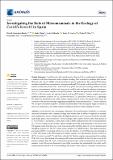Por favor, use este identificador para citar o enlazar a este item:
http://hdl.handle.net/10261/265073COMPARTIR / EXPORTAR:
 SHARE SHARE
 CORE
BASE CORE
BASE
|
|
| Visualizar otros formatos: MARC | Dublin Core | RDF | ORE | MODS | METS | DIDL | DATACITE | |

| Título: | Investigating the role of micromammals in the ecology of Coxiella burnetii in Spain |
Autor: | González-Barrio, David CSIC ORCID; Jado, Isabel; Viñuela, Javier CSIC ORCID; García, Jesús T. CSIC ORCID ; Olea, Pedro P. CSIC ORCID; Arce, Fernando; Ruiz-Fons, Francisco CSIC ORCID | Palabras clave: | Micromammals Zoonosis Coxiella burnetii Q fever |
Fecha de publicación: | 2021 | Editor: | Multidisciplinary Digital Publishing Institute | Citación: | Animals 11(3): 654 (2021) | Resumen: | Coxiella burnetii, the causal agent of human Q fever and animal Coxiellosis, is a zoonotic infectious bacterium with a complex ecology that results from its ability to replicate in multiple (in)vertebrate host species. Spain notifies the highest number of Q fever cases to the ECDC annually and wildlife plays a relevant role in C. burnetii ecology in the country. However, the whole picture of C. burnetii hosts is incomplete, so this study seeks to better understand the role of micromammals in C. burnetii ecology in the country. Spleen samples from 816 micromammals of 10 species and 130 vaginal swabs from Microtus arvalis were analysed by qPCR to detect C. burnetii infection and shedding, respectively. The 9.7% of the spleen samples were qPCR positive. The highest infection prevalence (10.8%) was found in Microtus arvalis, in which C. burnetii DNA was also detected in 1 of the 130 vaginal swabs (0.8%) analysed. Positive samples were also found in Apodemus sylvaticus (8.7%), Crocidura russula (7.7%) and Rattus rattus (6.4%). Positive samples were genotyped by coupling PCR with reverse line blotting and a genotype II+ strain was identified for the first time in one of the positive samples from M. arvalis, whereas only partial results could be obtained for the rest of the samples. Acute Q fever was diagnosed in one of the researchers that participated in the study, and it was presumably linked to M. arvalis handling. The results of the study are consistent with previous findings suggesting that micromammals can be infected by C. burnetii. Our findings additionally suggest that micromammals may be potential sources to trace back the origin of human Q fever and animal Coxiellosis cases in Europe. | Descripción: | This article belongs to the Special Issue Zoonoses and Wildlife: One Health Approach. | Versión del editor: | https://doi.org/10.3390/ani11030654 | URI: | http://hdl.handle.net/10261/265073 | DOI: | https://doi.org/10.3390/ani11030654 | E-ISSN: | 2076-2615 |
| Aparece en las colecciones: | (IREC) Artículos |
Ficheros en este ítem:
| Fichero | Descripción | Tamaño | Formato | |
|---|---|---|---|---|
| investigatiSpai.pdf | 803,58 kB | Adobe PDF |  Visualizar/Abrir |
CORE Recommender
Page view(s)
33
checked on 23-abr-2024
Download(s)
46
checked on 23-abr-2024
Google ScholarTM
Check
Altmetric
Altmetric
Este item está licenciado bajo una Licencia Creative Commons

